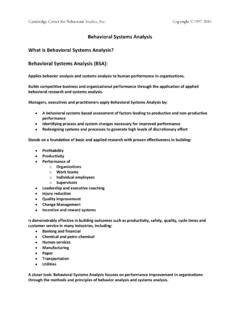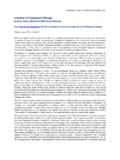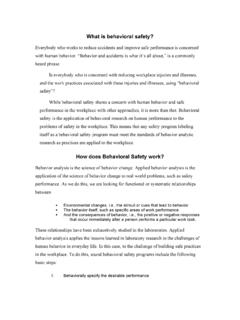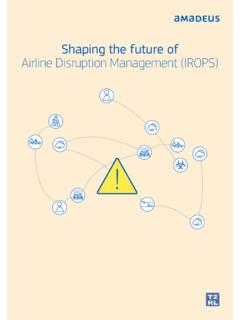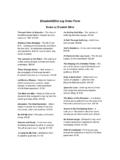Transcription of The World's First Look at Shaping: B.F. Skinner's Gutsy Gamble
1 Cambridge Center for Behavioral Studies, Inc. The World's First look at shaping : Skinner's Gutsy Gamble Gail B. Peterson Last summer I told the story of Skinner's discovery of shaping (Peterson, 2000). This summer I have a follow-up story about the First photographic demonstration of shaping to the American public and, indeed, to the English-speaking people of the world at large. Included here are some pictures which, to my knowledge, have appeared only once before, almost a half-century ago, in look magazine. I suspect that there are few people on the planet today under the age of 50 who have seen these pictures, and probably very few over 50 who have seen them (or remember having seen them). But what I hope will be found of greater interest is the story behind these pictures and the glimpse it gives us of Skinner's bold ingenuity and downright good luck. Let me begin by giving a brief recap of last summer's story.
2 It appears that none of the operant behavior Skinner had so carefully studied and written about prior to 1943 had been hand-shaped. The lever pressing by rats described in The Behavior of Organisms (Skinner, 1938) involved no hand- shaping , nor had hand- shaping been used in training the behavior chain performed by the celebrated Pliny (Life magazine, 1937). Although Skinner had built, programmed, and adjusted the equipment by hand, as the animal behaved in the experimental space, the consequences of its behavior were delivered with no hands, being totally controlled by the apparatus instead. As noted in the earlier article, Skinner clearly had a pretty good hunch, very early on, that new and elaborate forms of behavior could be effectively brought out or "differentiated" from even the most inert original behavioral material by an astute human observer who hand-actuated reinforcement according to the method of successive approximations. Nevertheless, he evidently never actually tried it until one day in 1943 on the top floor of a flour mill near downtown Minneapolis.
3 The behavior shaped that day was even more unlikely than the geographic location: Skinner, with the help of grad students Keller Breland and Norman Guttman, shaped a pigeon to bowl. The pigeon was trained to swat a little wooden bowling ball with its beak, propelling it down a miniature bowling alley into some tiny bowling pins. As strange as it may sound, the successful hand- shaping of this behavior was a genuine eureka experience for Skinner and his students. Skinner refers to it repeatedly in his memoirs and autobiographies as a very illuminating moment in his career (cf., Skinner, 1958, 1972, 1979). Why was the discovery of hand- shaping so important? It was important to Skinner at the time, in my opinion, because of the impact it had on his thinking about social behavior, human social behavior in particular, and especially human verbal behavior. But putting theoretical issues aside, history has shown the discovery of hand- shaping to be of monumental practical significance because of the impact it has had on the actual practices of people who need or want to change behavior.
4 It was Skinner's shaping that pigeon to bowl that got the ball rolling, if you will, in our modern day fields of Applied Behavior Analysis (cf., Cooper, Heron, & Heward, 1990; Chance, 1999), behavior modification (cf., Kazdin, 2000; Martin & Pear, 1996; Sarafino, 2000), biofeedback (cf., Olton & Noonberg, 1980; Schwartz, 1995), Precision Teaching (cf., Lindsley, 1971, 1972, 1990, 1992), performance management (cf., Daniels, 2000, 2001), and all the other practical applications of operant conditioning principles. And though it took 40 or 50 years to catch hold, the current revolution we are seeing in the field of practical animal training Cambridge Center for Behavioral Studies, Inc. can also be traced directly to that fateful day in 1943 (cf., Breland & Breland, 1951, 1966; Donaldson, 1996; Pryor, 1994, 1995, 1999; Ramirez, 1999; Reid, 1996). Throughout his life and career, Skinner was a man of great self-confidence, with strong personal convictions about the essential correctness of his view on the determinants of behavior.
5 He was so sure of himself and his views, in fact, that he would occasionally give rather glib accounts that, frankly, may have gone a bit beyond the established facts of the matter. I alluded to an example of this above: he described, quite convincingly, the process of hand- shaping several years before he or anyone else had actually ever done it. In his important 1937 "Reply to Konorski and Miller" paper, Skinner gave the distinct impression that he had hand-shaped rats to lever press, an observation which was of central theoretical significance to the point at issue in that historic academic exchange. However, in discussing the matter some 40 years later, Skinner, to his everlasting credit, came clean and fessed up that he had not actually ever shaped lever pressing that way, but "I was sure it could be done" (Skinner, 1979, p. 185). Thus, paragon of empirical science virtue though he most definitely was, this "Reply to K & M" episode shows that he was not above venturing beyond the strict empirical facts from time to time, sticking his theoretical neck out a little and engaging in flat-out speculation - - but doing it in a way that didn't sound the least bit like He appears to have done a similar thing again in his 1951 Scientific American article on "How to Teach Animals".
6 This time, however, he soon got called on it. That 1951 paper is a landmark article in the history of practical animal training. This was the article in which the term shaping was used, at least in print, for the very First time. It was also the article in which the use of a clicker as a conditioned reinforcer was First described (again, in print).2 Skinner also described in that paper something very much like our modern practice of target training, although he didn't call it that and didn't expand upon how a target can be used to prompt other behavior which can then be strengthened by reinforcement. That short four-page article is probably the most concise tutorial one could ever find on the basic principles of operant conditioning. It should be required reading for anyone interested in the field. Also contained within that neat little 1951 article is a confident speculation (once again, not sounding at all like speculation) which could have proved quite embarrassing to Skinner, and on a fairly grand scale at that.
7 Without having had any experience actually doing it himself beforehand and probably without having seen anyone else do it either3, Skinner confidently described how easy it is, via shaping with positive reinforcement, to train a dog to do tricks. In particular, he gave the example of how easy it is to train a dog to lift its head, turn a little pirouette, and dance. As a second test, let us say, you want to teach the dog to lift its head in the air and turn around to the right. The general procedure is the same, but you may need some help in sharpening your observation of the behavior to be reinforced. As a guide to the height to which the dog's head is to be raised, sight some horizontal line on the wall across the room. Whenever the dog, in its random movements, lifts its head above this line, reinforce immediately. You will soon see the head rising above the line more and more frequently. Now raise your sights slightly and reinforce only when the dog's head rises above the new level.
8 By a series of gradual steps you can get the dog to hold its head much higher than usual. After this you can begin to emphasize any turning movement in a clockwise direction while the head is high. Eventually the dog should execute a kind of dance step. If you use available food carefully, a single session should suffice for setting up this behavior. (Skinner, 1951, p. 27) When Skinner's article came out in Scientific American, it was read by a writer for look magazine4 who must also have been something of a skeptic. Joseph Roddy promptly paid Skinner a visit at Harvard, and Cambridge Center for Behavioral Studies, Inc. essentially told him that if this method of training dogs was as slick as he claimed, then look wanted pictures of it for their magazine. Skinner later wrote, "As a poker player might have put it, look was calling me." (Skinner, 1983, p. 42) Skinner unhesitatingly took up the challenge; I think it was a rather Gutsy Gamble .
9 Accordingly, Mr. Roddy acquired a dog, a young Dalmatian (registered name "Roadcoach Cheerful", call name "Agnes"), and brought her to Skinner. In the resulting magazine article, Roddy wrote: At Skinner's workshop, the Harvard Psychological Laboratory in Cambridge, the feeling is that a man can have a dog doing anything reasonable he could want a dog to do within twenty minutes of their First encounter. We doubted that, and visited Skinner with a camera on our hip and Agnes on our leash. Dog and psychologist were introduced to each other. Skinner asked us what we would have the dog do, and we said, "Run up the wall." Twenty minutes later, we were convinced. ( look magazine, May 20, 1952, p. 17) How did Skinner do it? He was darn clever: First of all, he realized that the taking of photographs would, obviously, be a very high priority feature of this whole look magazine enterprise, and it was therefore important that Agnes be at ease with flash bulbs. Also, for the pictures to be fair, accurate, and meaningful, it would be best if each photo corresponded to a progressive step in the shaping process.
10 The answer was to use the flash of the photographer's strobe light itself as the conditioned reinforcer (instead of a clicker). Accordingly, Agnes was given pretraining in which the flash of the strobe was immediately followed by a small cube of beef. This training served both to countercondition any unwanted adverse reactions Agnes might have had to the flash, and to establish the flash as a marker, a bridge, a conditioned reinforcer. So, when the time came to put up or shut up, both Skinner and Agnes were ready. Yes darn clever5. Cambridge Center for Behavioral Studies, Inc. The actual training and photo shoot took place in the apartment of Skinner's graduate student, Charlie Ferster. Skinner set things up (for real this time) in much the way he had described one might do in the Scientific American piece (see pictures above): he attached some horizontal stripes to the wall which he then used to gauge the dog's responses of lifting its head higher and higher.
